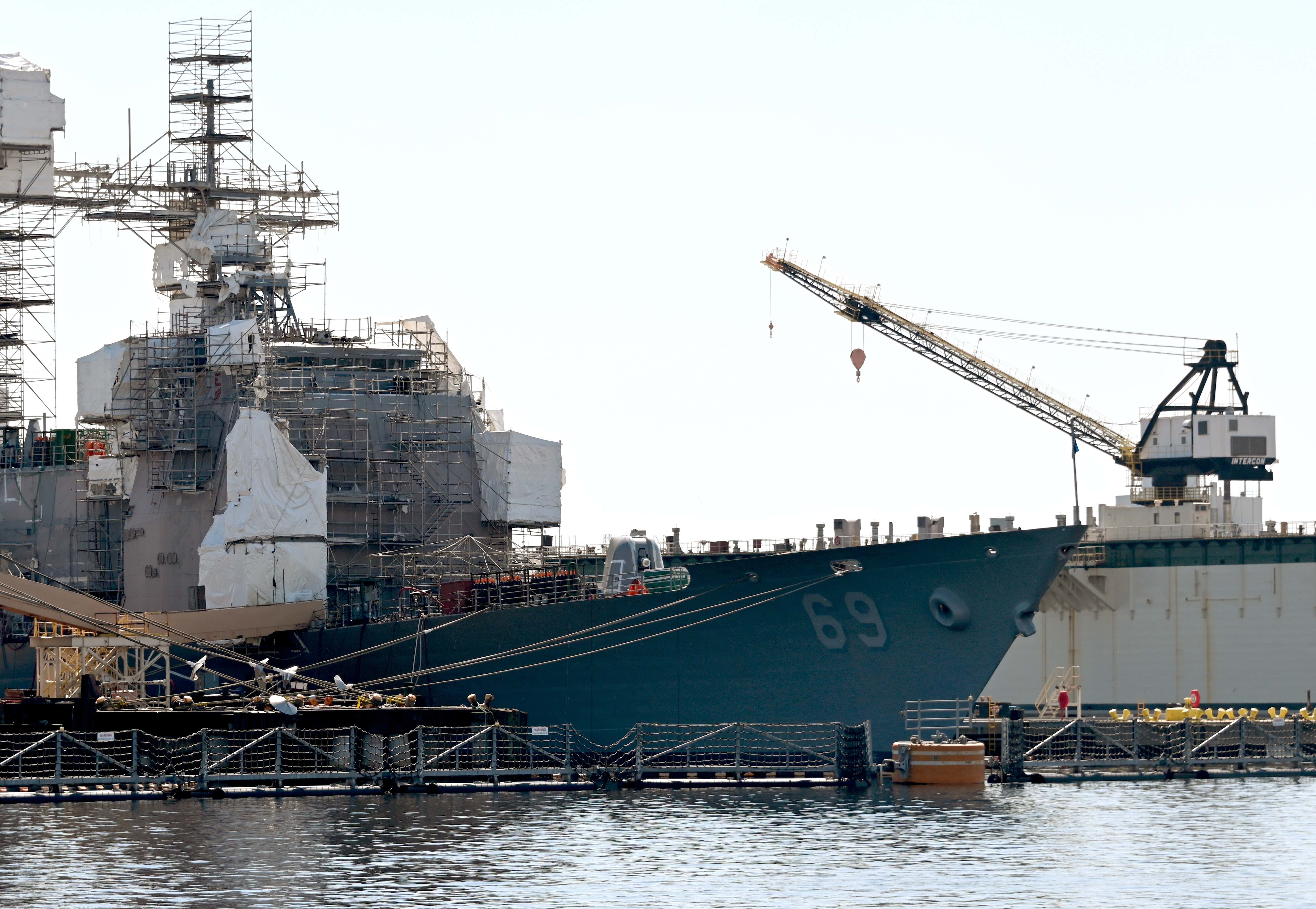
THE PENTAGON – After unveiling a budget that wants to decommission 11 warships next year, Navy officials are appealing to the public to allow the service to move ahead with their proposal.
Officials last week reiterated the Navy’s divest-to-invest approach, which argues the service needs to shed older ships to invest in newer capabilities and platforms.
“One of the things we have to get real about, instead of talking about estimated service life, talking about actual service life,” Chief of Naval Operations Adm. Mike Gilday said last week at the annual McAleese Conference.
“Ships need to be workable and they need to be usable. So those ships that aren’t either – usable or workable – I might be able to replace those with something that’s a little bit more agile. We may have to use them a little bit differently – get back to driving adaptability, effecting change,” he added.
It’s an argument the Navy has made before and lawmakers have rejected. In unveiling its Fiscal Year 2024 budget proposal, the Navy announced plans to retire eight ships before they reach their expected service lives: two Independence-class Littoral Combat Ships, three Whidbey Island-class dock landing ships and three Ticonderoga-class cruisers. Of those eight vessels, the service tried decommission four of them last year: dock landing ships USS Germantown (LSD-42), USS Gunston Hall (LSD-44) and USS Tortuga (LSD-46) and cruiser USS Vicksburg (CG-69). But lawmakers ultimately blocked the service from shedding those hulls in FY 2023. The Navy is trying once again to retire them.
“The entering argument for us is our top line. And so I said earlier, we’re only going to have a navy as big as we can afford. And so then what we do is we stratify all of our platforms in terms of lethality, and that’s also informed by sustainability – what’s going to cost just to keep those ships – as well as reliability,” the CNO said.
“The friction with the Congress is capacity in the repair yards and I get that. But just having visited a repair yard with a cruiser that’s undergoing modernization as well as an older amphib, they are not making money on those ships,” Gilday added. “And they are not lethal. We’re not going to get them underway for the fight. So my proposal is let’s reinvest in something that is going to be lethal, and it is going to put us in a position of advantage against the pacing threat.”
In addition to the eight ships the Navy wants to decommission early, the service also wants to retire cruisers USS Antietam (CG-54) and USS Leyte Gulf (CG-55), and Los Angeles-class submarine USS San Juan (SSN-751). Those ships have remained in the fleet past their expected service lives.
Cruisers
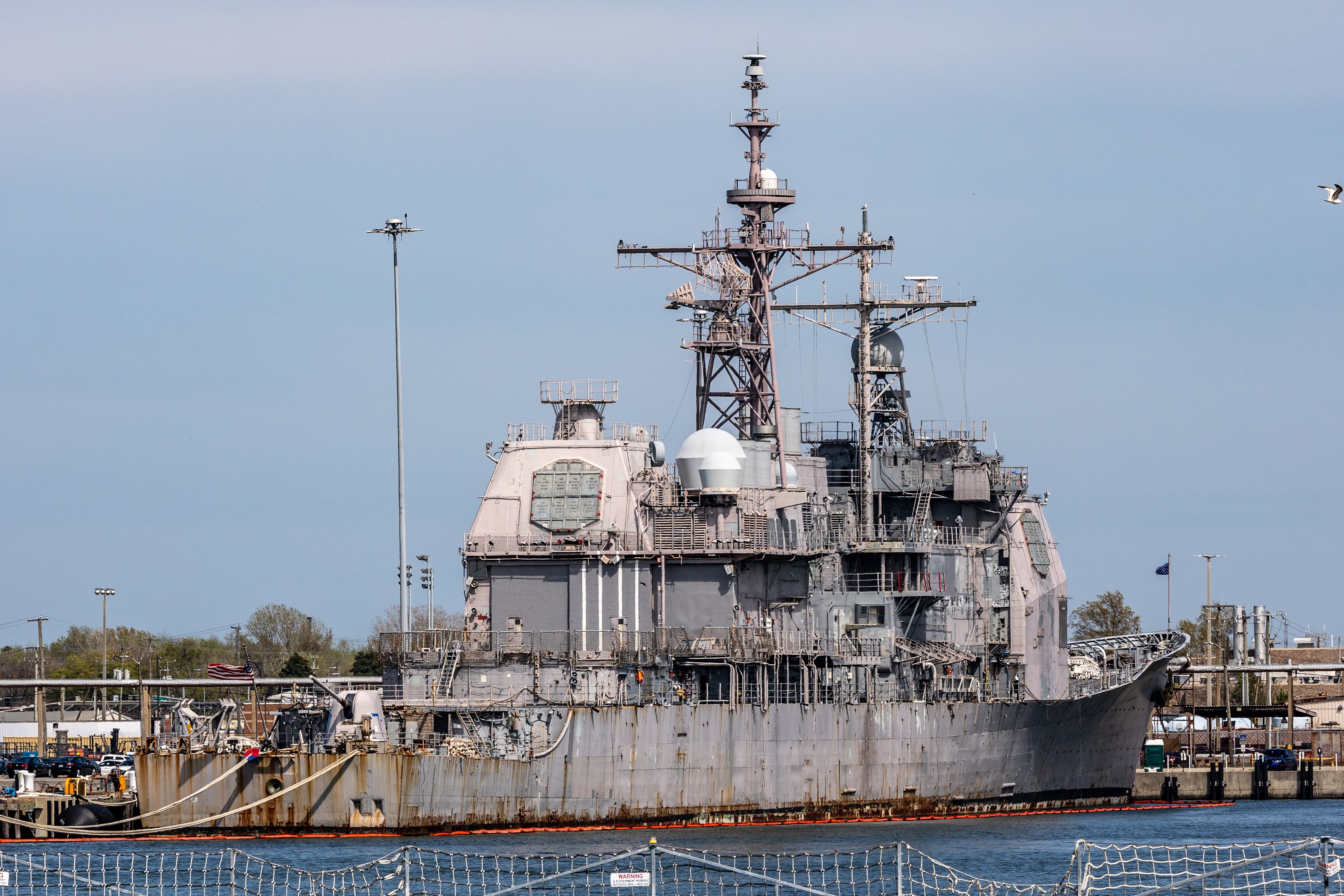
For the last several budget cycles, the Navy has tried to decommission its aging Ticonderoga-class cruisers after pursuing a modernization program meant to extend the ships’ service lives past their planned 35 years.
“The cruiser mod program – we had kind of one vision how that’d play out. There were a number of factors that kind of led into how the strategy was developed. But I can tell you – the ones that are in the yard right now – the cruisers are just, I’ll say a little bit long in the tooth,” Naval Sea Systems Command chief Vice Adm. Bill Galinis said last week.
“We know how to modernize combat systems. We know how to modernize C4I systems, even the [hull, mechanical and engineering] systems. But [what] we’re seeing on the cruisers right now is really just the infrastructure of the ship. Its’ the hull. It’s the deckhouse. It’s the structural members of the ship. That’s really where the challenge is.”
As lawmakers considered the service’s proposal to decommission Vicksburg last May, the ship was 85 percent of the way through the modernization overhaul meant to extend its service life at BAE Systems Ship Repair in Norfolk, Va. Jay Stefany, the principal civilian deputy to the assistant secretary of the Navy for research, development and acquisition, at the time confirmed to lawmakers that the service spent nearly $300 million to upgrade Vicksburg. Congress rejected the service’s proposal, barring it from decommissioning the cruiser in FY 2023.
In addition to Vicksburg, the FY 2024 request wants to decommission USS Shiloh (CG-67), as outlined in the FY 2023 30-year shipbuilding plan, and moves up the decommissioning for USS Cowpens (CG-63) from FY 2026. The accelerated timeline for Cowpens would save $130.1 million across the five-year Future Years Defense Program, according to the Navy.
Without naming specific ships, Gilday said cruisers are having to pull into ports while on deployment for structural repairs.
“For cruisers as an example, I’m pulling them into Souda Bay, Crete or I’m pulling them into Djibouti during deployment to fix holes in the ship below the water line. I got water going into berthing compartments. So those are considerations as well,” the CNO said.
Navy Secretary Carlos Del Toro, speaking at the same conference last week, said he’d like to divest of the aging cruisers so he can put more money into the Arleigh Burke-class Flight III destroyers.
Over the years, Navy officials have argued to Congress that the dollars they’re putting toward the Ticonderoga-class cruisers would be better spent on modernization efforts.
“That’s our challenge right now with the cruisers is just, we’re not going to get the return on investment if we were to do all the work that we need to do on those ships and make them combat relevant to the force going forward,” Galinis said at the McAleese conference.
Landing Ship Docks
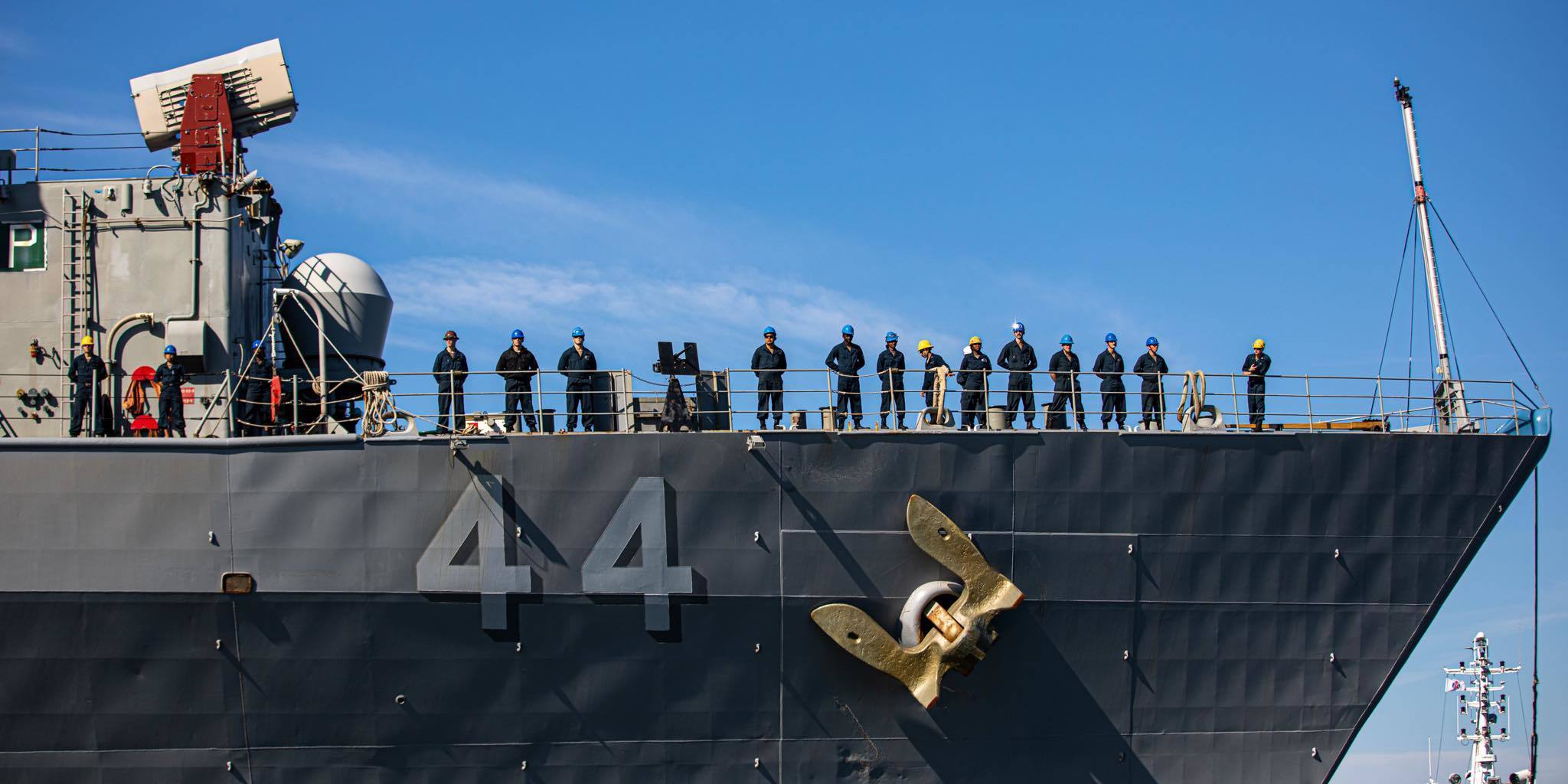
In addition to the cruisers, the Whidbey Island-class dock landing ships – planned to have 40-year service lives – have also been at the top of the Navy’s decommissioning list the last few years.
Asked last week how much it would cost to keep Germantown, Gunston Hall, and Tortuga in the fleet, Gilday said he didn’t know the exact number but that it’s a “substantial” amount of money.
“If I take a look at what eats up our accounts – I take a look in a repair yard – I take a look at new work and growth work. On average, our new work is about 5 percent and our growth work is at about 16 percent across ships in the Navy and shipyards,” Gilday said.
“With that particular old amphibious ship, new work’s at 68 percent. So she is 4 years behind out of the shipyard. She’s costing us millions more than we need. We have to make tough decisions here. That’s money that we could pivot somewhere else,” the CNO added. He did not disclose the name of the amphibious ship.
Like Vicksburg, the Navy as of last May had spent nearly $300 million to upgrade Tortuga, which at the time was in a yard for repairs.
Gilday said he’ll have more maintenance availabilities to fund next year, and with ships waiting to go into the yards, he could use that money for other overhauls. Del Toro also pointed to the ships waiting for repairs and argued the older ships have more issues once they get to the yards.
“You want to reduce maintenance delays in the Navy to get the most bang out of the buck for the American taxpayer, well get rid of those old ships that have been sitting in shipyards for upwards of three and four years. They’re old, folks. As you open them up, you discover even more problem sets with them. They’re very close to their extended service life. You may ask why are they under their extended service life? Well, we’ve operated the living hell out of these ships, Del Toro said.
The Navy secretary said he recently saw Germantown, which has a crane aboard that has not been operable for six years. Despite efforts to repair it for several months, Del Toro said the crane is still not functioning.
“The wood deck on Germantown is starting to break through. Okay, she’s the last LSD with a wood deck in the Navy. You know how much it costs to replace that wood deck? I don’t know either, but I know it’s a lot of money. Okay, and what I will tell you is, what am I going to get out of that? Am I going to get one more year of operation at the cost of $250, $300, $400, $500 million?”
While Del Toro argued he would rather put that money toward new LPDs or the Marine Corps’ pursuit of Landing Ship Medium, the Navy has effectively ended the LPD line by pausing procurement for an indefinite amount of time.
Littoral Combat Ships
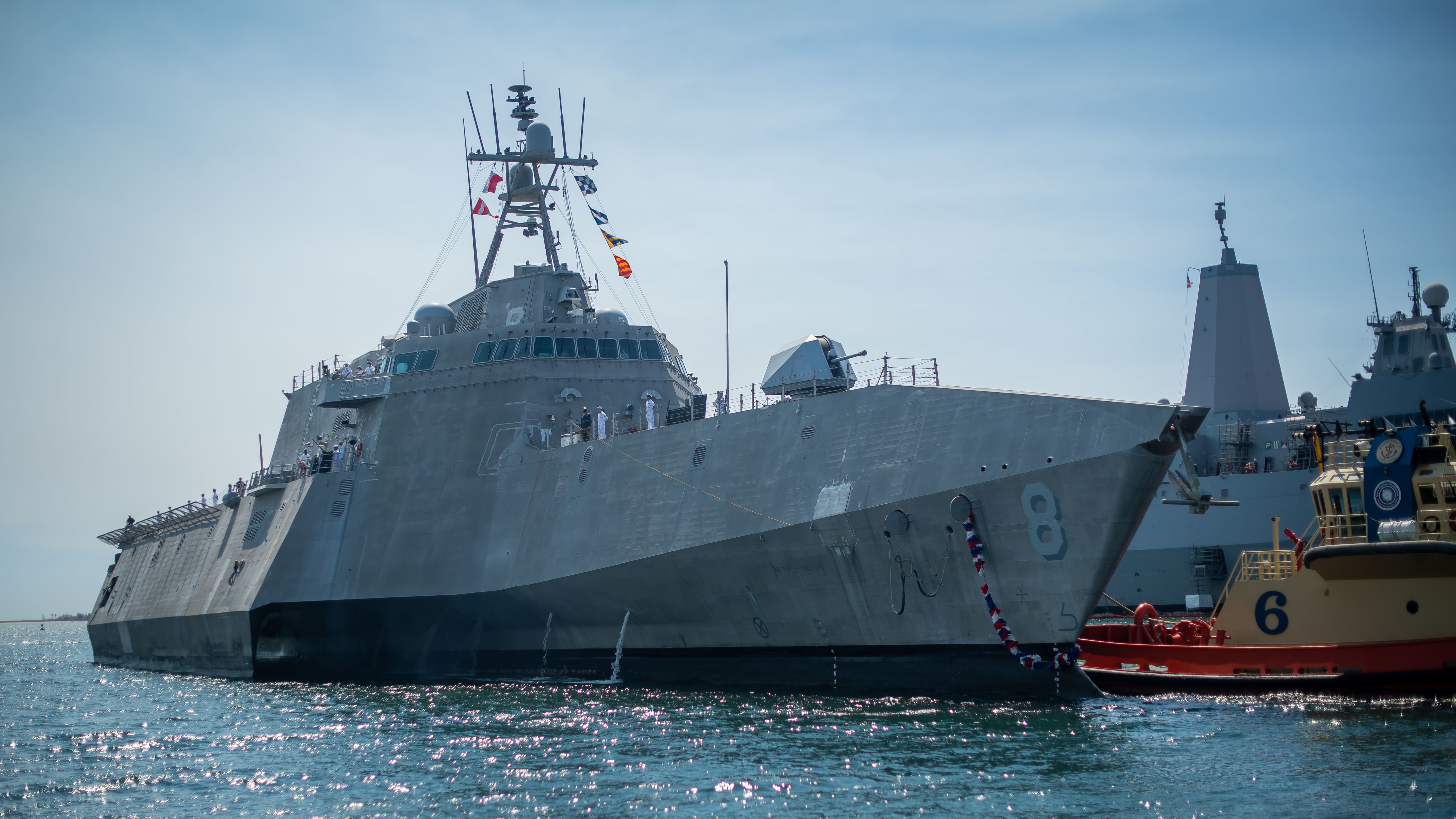
While the Navy is trying to retire the fleet’s aging vessels, the service has also repeatedly asked to decommission some of the newest ships in service.
Over the last few years, the Navy has tried to decommission both the Freedom-class and Independence-class LCSs, but focused more intently on the Lockheed Martin and Fincantieri Marinette Marine-built Freedom ships because of a class-wide problem with the combining gear that marries the ship’s diesel engines with its gas turbines.
In accordance with last year’s 30-year shipbuilding plan, the FY 2024 recent budget proposal wants to decommission Independence-class Littoral Combat Ships USS Jackson (LCS-6) and USS Montgomery (LCS-8), commissioned in 2015 and 2016, respectively. Austal USA built both ships – slated to each have a 25-year service life – at its yard in Mobile, Ala.
Gilday last year argued that the Freedom-class ships could not stand up well in a potential conflict against China or Russia. Galinis last week made the same point about the Independence-class ships.
“You start looking at some of the earlier Littoral Combat Ships. Again, some of the things that we learned on the early ships of the two classes – both the Freedom and the Independence class – and then you look at the armament and the weapons, the combat capability on those ships, they just don’t support the high-end fight that we’re getting ready for right now. And so again, look at it really from a combat capability perspective and that’s what we’re kind of looking with why those ships should probably come out of service,” Galinis said.
Congress
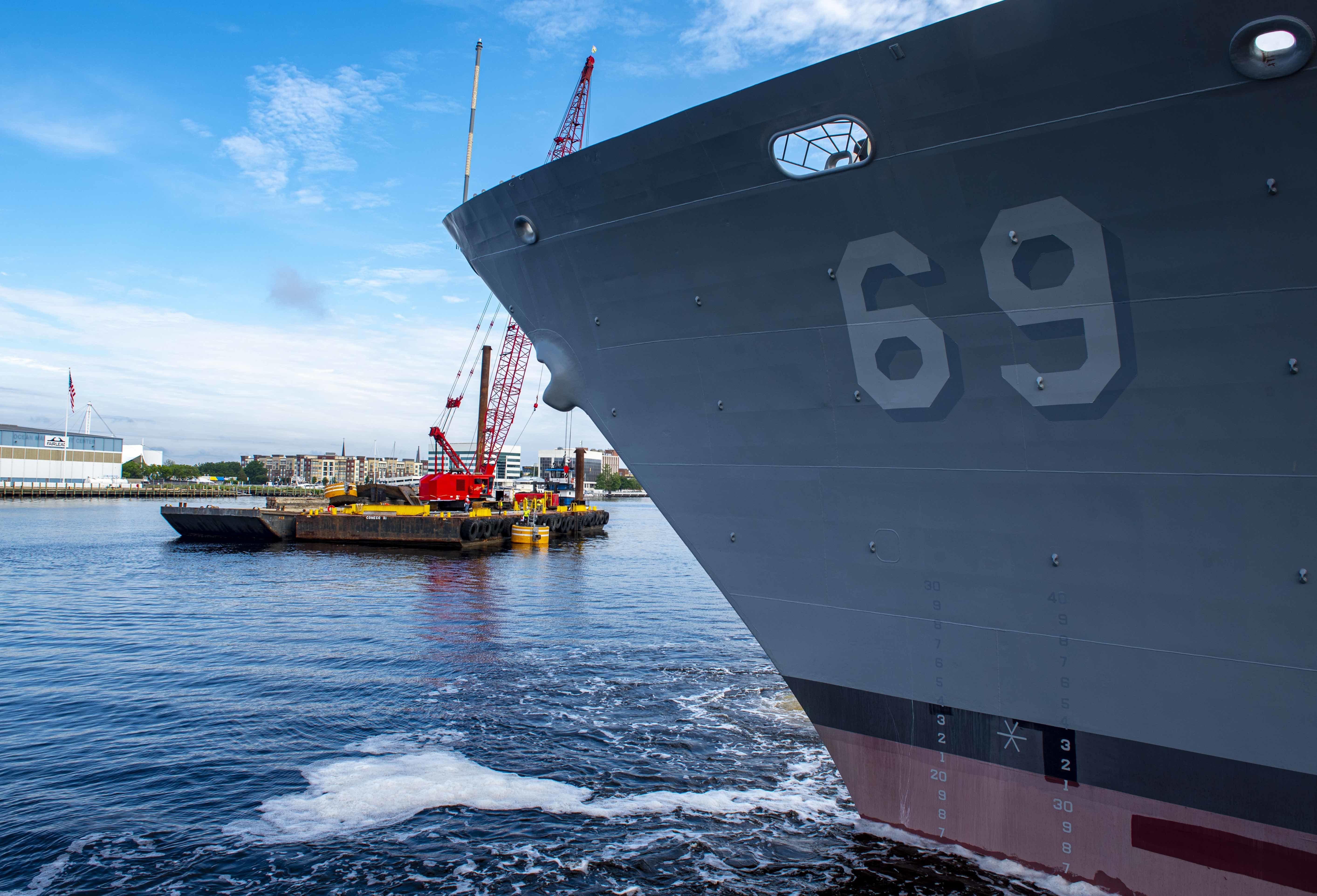
While the Navy’s proposal lays out its decommissioning plans for the year, Congress will ultimately get the final say.
Lawmakers have criticized both the Navy’s dives to invest budgeting approach and its decommissioning strategies, but have also allowed the service to retire older ships.
“Some of these ships – especially the Littoral Combat Ships – are among the newest in the fleet. The Navy claims they don’t have enough sufficient funding to maintain and operate these ships, but that’s not the case. Instead, they’ve mismanaged billions of dollars in maintenance funding. One glaring example of this is the USS Vicksburg, a cruiser up for decommissioning this year,” Rep. Kay Granger (R-Texas), who now chairs the House Appropriations Committee, said at a hearing last year.
“At a time when the ship is still in its maintenance period, the Navy is proposing to scrap it. If the Navy experts expect Congress to support its vision for this fleet, it must do a much better job of managing the inventory it has. We will not stand idly by as valuable taxpayer funds are wasted.”
Of the five cruisers the Navy wanted to divest of in FY 2023, lawmakers only stopped the service from retiring Vicksburg, which had not reached its 35-year service life and was nearly finished with its modernization overhaul. The other four cruisers had either reached or surpassed their expected 35-year service lives.
Last year Congress also saved the three LSDs up for decommissioning again this year – Germantown, Gunston Hall, and Tortuga – which are now 38, 35, and 34 years old, respectively. Lawmakers also saved five Littoral Combat Ships but did not specify which ones in the FY 2023 policy bill.





